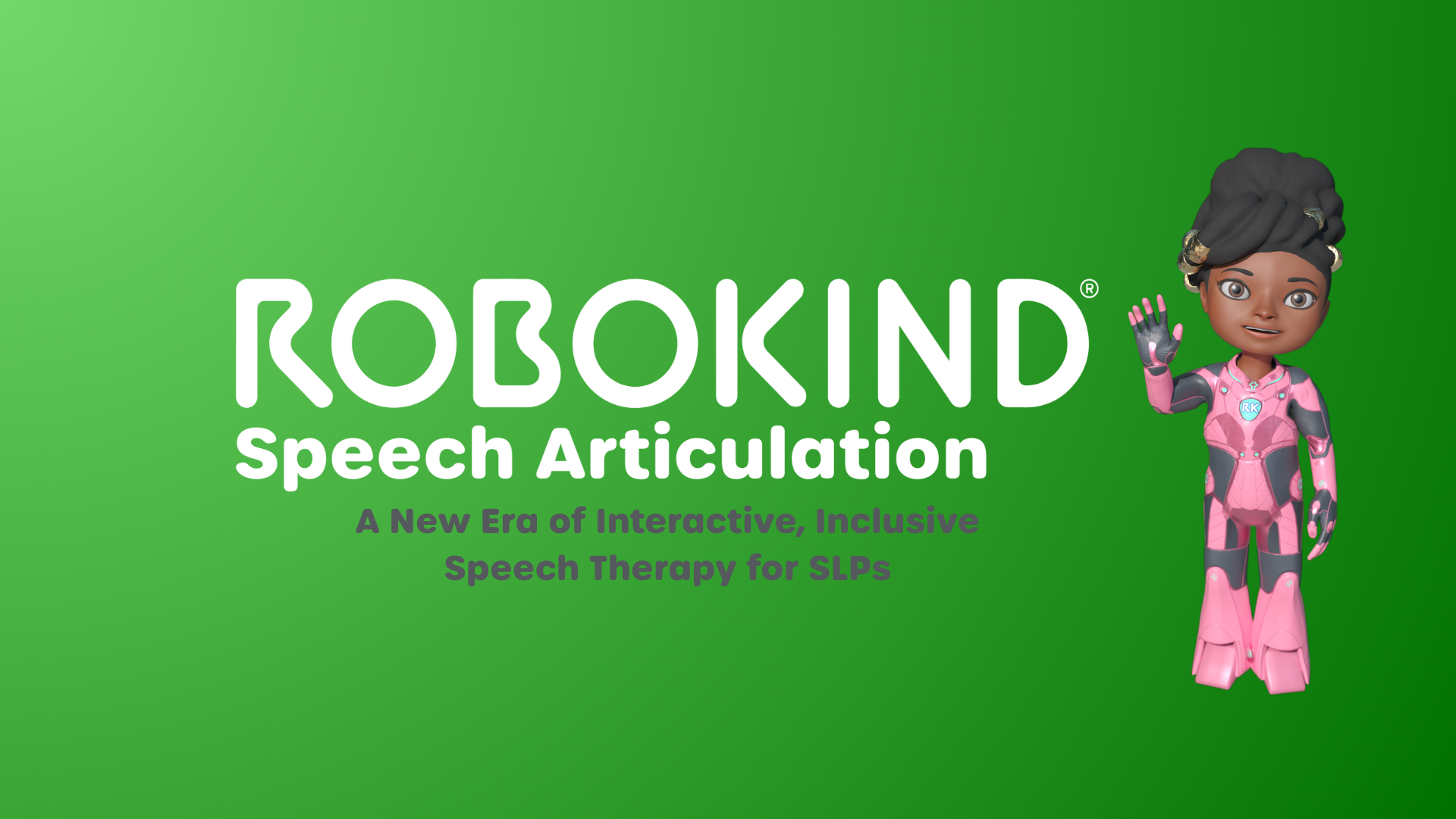If you are a Speech-Language Pathologist (SLP) searching for a curriculum that blends structured articulation instruction with engaging technology, look no further than RoboKind’s Supplemental Speech Articulation Curriculum for SLPs. Come explore a curriculum that empowers both you and your students—through Evidence-based Practices and joyful, interactive learning.
Designed as a speech-focused adaptation of RoboKind’s evidence-based phonics program, this innovative tool delivers 41 digital lessons aligned to IEP goals, national standards, and the Science of Reading—each crafted specifically to support the success of students with speech sound disorders and diverse learning needs.
Why Research Supports This Approach
Evidence consistently shows that effective speech therapy for students developing speech sound accuracy should be grounded in systematic, explicit, and multisensory instruction (Baker & McLeod, 2011). RoboKind’s curriculum does exactly that—providing highly structured lessons using I-VAKT™: Interactive Technology, Visual, Auditory, Kinesthetic, and Tactile Techniques.
Furthermore, instruction focused on phonemic awareness and articulation is foundational to both speech intelligibility and early literacy development (Gillon, 2004). By using RoboKind’s platform, SLPs can simultaneously address articulation goals and support pre-literacy skills through engaging digital activities.
What Makes It Different?
Phonemic Formation Support
Each lesson includes step-by-step guidance to teach students how to produce individual speech sounds. Teachers and students benefit from audio samples, x-ray demonstration videos, and voicing comparisons (e.g., /p/ vs /b/) to enhance motor planning and phonemic discrimination.
The built-in digital mirror tool allows students to visually monitor their articulation, a strategy proven to improve accuracy through visual feedback (Preston & Leaman, 2014). These supports are critical for students experiencing childhood apraxia of speech or other motor-based articulation challenges.
Digital Sound Wall + Vowel Valley
Phonemic Formation Support
Unlike static posters, RoboKind’s interactive Digital Sound Wall and Vowel Valley are dynamic tools that engage multiple senses. Students can:
- Hear the target sound
- Watch an x-ray video of how the sound is produced
- See visual cues of mouth positioning
This aligns with multisensory instruction principles, shown to be effective for students with speech and language impairments (Ehri et al., 2001; Foorman et al., 2016). Repetition and sensory-rich experiences build lasting phoneme-grapheme connections and muscle memory for articulation. These tools are part of RoboKind’s I-VAKT™ approach, offering Interactive Technology, Visual, and Auditory engagement for effective phoneme acquisition.

Interactive Tools That Keep Students Engaged
Phonemic Formation Support
SLPs know that motivation matters. RoboKind’s curriculum is packed with interactive technology that reinforces practice in a fun, purposeful ways:
- Students interact with Silly Sentences by covering letters to isolate and articulate target phonemes in a playful way.
- Flashcards with practice words provide targeted repetition in various word positions.
- An Assessment Spinner enables randomized practice while allowing teachers to track progress toward learning objectives, IEP goals, and national standards.
- A Digital Reward Jar celebrates student effort with stars and trophies.
- The friendly Virtual Avatar Teaching Assistant offers consistent, supportive prompts—keeping students engaged and reducing preparation time for SLPs.
Research supports the integration of interactive, technology-assisted instruction in speech therapy, particularly when it allows for real-time feedback and modeling (Wren et al., 2013).

Built for Diversity: English Language Learners Support Included
Many SLPs serve English Language Learners (ELLs), whose articulation may reflect the characteristics of their native phonemic systems. RoboKind includes an ELL Phoneme Guide covering six common home languages—Spanish, Arabic, Mandarin, Vietnamese, Tagalog, and Korean.
This guide equips SLPs with insights into common substitution patterns (e.g., /v/ → /b/ or /f/) and provides strategies for culturally responsive articulation therapy. As recommended by the American Speech-Language-Hearing Association (ASHA, 2020), understanding a student’s linguistic background is essential to avoid misdiagnosis and deliver effective intervention.
Why It Works for SLPs
RoboKind’s Speech Articulation Curriculum is:
- Evidence-based
- Aligned with IEP goals and national standards
- Designed to reduce prep time
- Engaging for diverse learners
Designed for ease of use, the RoboKind® Speech Articulation Curriculum simplifies preparation and empowers SLPs to deliver targeted, joyful speech instruction.
Learn more by listening to the Interactive Speech Therapy for SLPs Podcast!
Disclaimer: To make this blog post more accessible and engaging, we created an audio version in the form of a podcast featuring two AI voices discussing the content. While the podcast is delivered by AI, the conversation was entirely customized and controlled by our team to ensure accuracy and alignment with the original blog post.
Ready to simplify your sessions and energize your learners?
Join the waiting list today: robokind.com/teacher
References
- American Speech-Language-Hearing Association. (2020). Cultural competence in service delivery. https://www.asha.org/practice-portal/professional-issues/cultural-competence/
- Baker, E., & McLeod, S. (2011). Evidence-based practice for children with speech sound disorders: Part 1 narrative review. Language, Speech, and Hearing Services in Schools, 42(2), 102–139. https://doi.org/10.1044/0161-1461(2010/09-0075)
- Ehri, L. C., Nunes, S. R., Stahl, S. A., & Willows, D. M. (2001). Systematic phonics instruction helps students learn to read: Evidence from the National Reading Panel’s meta-analysis. Review of Educational Research, 71(3), 393–447.
- Foorman, B. R., Coyne, M., Denton, C. A., Dimino, J., Hayes, L., Justice, L., ... & Wagner, R. (2016). Foundational skills to support reading for understanding in kindergarten through 3rd grade (NCEE 2016-4008). National Center for Education Evaluation and Regional Assistance.
- Gillon, G. T. (2004). Phonological awareness: From research to practice. Guilford Press.
- Preston, J. L., & Leaman, M. (2014). Assessment and treatment of speech sound disorders: A dual approach. Language, Speech, and Hearing Services in Schools, 45(4), 299–310.
- Wren, Y., Roulstone, S., Miller, L. L., Emond, A., & Peters, T. J. (2013). Computer-based intervention for children with speech sound disorder: A comparison of outcomes with and without speech and language therapy support. International Journal of Language & Communication Disorders, 48(4), 412–423. https://doi.org/10.1111/1460-6984.12022


